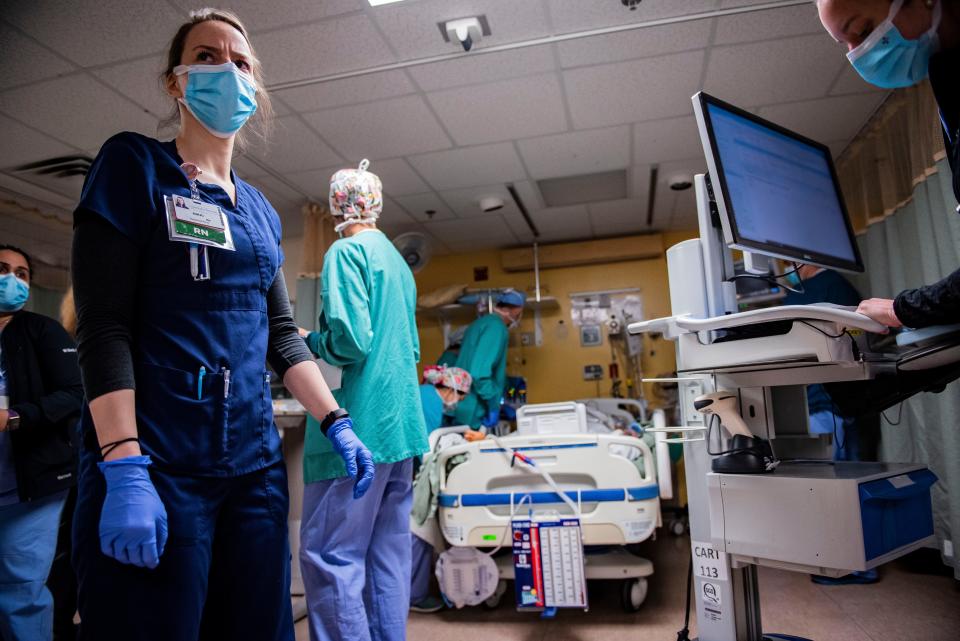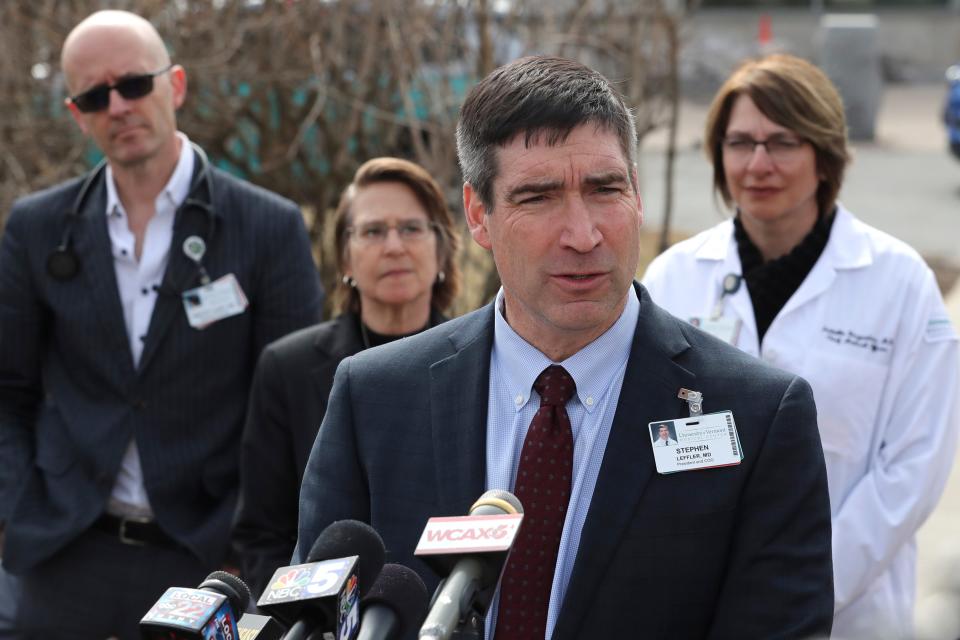Vermont has problems finding hospital beds for those in need. What a doctor says causes it
The University of Vermont Medical Center in Burlington assigns colors for three levels of operating conditions: red, green and yellow, just like a traffic light.
Green means everything is normal. Yellow means, "We're busy, but we'll get through it." Red means there's a crisis. More patients than beds. Dr. Stephen Leffler, president and chief operating officer for the Medical Center, told the Burlington Free Press there were fewer than 10 days last year when the hospital was not in the red. Same thing this year so far, with more patients than beds every day.
"It varies from day to day," Leffler said on Feb. 21. "I have a list for today. This morning we had 429 patients in beds. We had eight people waiting in the ED (emergency department) for a bed upstairs, four people waiting for psych beds, and we had 68 people today waiting for discharge, ready to leave, but no nursing home or long-term care unit available."

The hospital's 365 beds for medical and surgical patients, including the intensive care unit, are 99-100% full almost every day, according to spokeswoman Annie Mackin.
As a result, Vermont's health care system is engaged in a game of musical beds, with dozens of patients waiting for a place to land, either for long-term care outside the Medical Center, or for specialized care at the Medical Center, where there are doctors with skills unavailable anywhere else in the state. Ever since the pandemic in 2020, Medical Center staff have struggled with where to put too many patients.
"It's exhausting, but it's our job," Leffler said. "We want to be here when people need us. If you need services only we can provide, we (want to) have a bed for you. We deal with this every day."
Medical Center chief calls for more long-term care beds in Vermont
Testifying before a joint hearing of the House committees on health care and human services on Feb. 21, Leffler called for the state to do something about the lack of beds for long-term care in nursing homes and other facilities.
"There's a boarding crisis at hospitals across the state," Leffler said. "Patients can't get to the next stage of care. Since the pandemic, we've lost about 500 (long-term care) beds. Prior to the pandemic, it wasn't perfect, but the pandemic made it infinitely more difficult to discharge patients."

Prior to the pandemic, Leffler said, he would have said 20 patients being boarded in the Medical Center was too many.
"Last week, we had 83 patients waiting for discharge," he said. "That has a huge impact on the state of Vermont, not just the Medical Center. It affects every Vermonter visiting an ER across this state. More people need us now and our options to get people (out of the hospital) have shrunk."
More: How short staffing at Vermont nursing homes contributed to COVID-19 deaths
While Leffler is focused on getting back those 500 long-term care beds in nursing homes and other facilities Vermont lost as a result of the pandemic, he also realizes the Medical Center needs to increase its bed count.
"We're calculating how many more beds we need to have capacity for everyone," Leffler told the Free Press. "I can't tell you an exact number right now, but it will be more than 100 beds over the next 10 to 15 years. We want to be able to accept every patient who needs to come to us. That's our job, but literally most days right now every bed in every location is full."
Bed shortage is hard on hospitals, hard on patients, and 'massively expensive'
Owen Foster, an attorney and former federal prosecutor, was appointed by Gov. Phil Scott in 2022 to lead the Green Mountain Care Board, which regulates major areas of the health care system in the state, including hospital budgets. One of the Middlebury native's main concerns as chair of the Care Board is the situation Leffler describes: too many patients and too few beds.

"I see it percolating through (the health care system) in a number of different ways," Foster said. "One, it's really hard on the hospital and the hospital staff. That's certainly an issue. Two, it's really hard on the patient, who's not where they need to be for the best care, sometimes in inhumane conditions. Third, it's massively expensive to the system to have those patients backed up in a hospital."
Leffler testified to the joint House committees that the Medical Center spent about $3.2 million in the first quarter on patients it was boarding who were no longer covered by reimbursements from Medicare or Medicaid.
"I share (Leffler's) view we need to add long-term beds and we need to add them now," Foster said. "A lot of the problems we see come from the inability to move patients through the system."
Dwindling margins and dwindling cash plague Vermont hospitals
Vermont hospitals have dwindling margins and dwindling cash on hand, Foster said. Commercial insurance rates have gone "through the roof" as a result, as hospitals scramble to cover losses by asking for double-digit increases in insurance payments for procedures and appointments.
Foster and the Care Board are working with consultants to figure out how to change the health care system so it doesn't rely on ever increasing insurance payments. The Care Board is engaged in a three-step process, Foster said.
Step 1 was to meet with communities, physicians, payers and patients to understand from a "qualitative" standpoint what people needed.
One of the items on that qualitative list was wait times for medical appointments, which are often egregious. Foster had firsthand experience.
"I was unable to get a primary care doctor in this state for many years, including when I was chair of the Care Board," Foster said. "I called seven different places and didn't even get put on a wait list. I was a secret shopper. This is what people are dealing with."
Step 2, Foster said, is to review the data, and the final step is to speak with hospital boards and communities to roll out ideas for changes. The process will include a final written report sometime this summer. Then it will be up to local boards of hospitals to figure out what actions to take.
"There will be a set of recommendations about what we need to do to have an optimized system," Foster said.
Contact Dan D’Ambrosio at 660-1841 or ddambrosi@gannett.com. Follow him on X @DanDambrosioVT.
This article originally appeared on Burlington Free Press: UVM Medical Center struggles daily to find enough beds for patients

